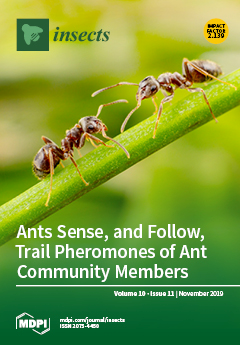The invasive Asian citrus psyllid,
Diaphorina citri (Hemiptera: Liviidae), is the primary vector of the phloem-infecting bacterium,
Candidatus Liberibacter asiaticus.
Candidatus L. asiaticus is the putative causal agent of Huanglongbing (HLB) disease, a destructive disease of
Citrus. While many
Citrus species are
[...] Read more.
The invasive Asian citrus psyllid,
Diaphorina citri (Hemiptera: Liviidae), is the primary vector of the phloem-infecting bacterium,
Candidatus Liberibacter asiaticus.
Candidatus L. asiaticus is the putative causal agent of Huanglongbing (HLB) disease, a destructive disease of
Citrus. While many
Citrus species are susceptible to
D. citri probing and HLB disease, there are marked behavioral differences in
D. citri probing responses and Ca. Liberibacter asiaticus infection severity among
Citrus species. Using four mandarin hybrid selections and pummelo plants variably resistant to
D. citri probing, oviposition, and survival, we explored probing differences using electropenetrography (EPG), conducted an oviposition and survival study, and determined host plant metabolites using gas-chromatography mass-spectroscopy (GC-MS). We found thirty-seven
D. citri probing variables to be significantly different among tested mandarin selections and pummelo, in addition to differential oviposition and survivorship abilities on tested plants. We found sixty-three leaf metabolites with eight being significantly different among tested mandarin selections and pummelo. Detailed analysis of probing behavior, oviposition, survivorship, and host plant metabolite concentrations reveals the complex, layered resistance mechanisms utilized by resistant
Citrus against
D. citri probing. EPG is a powerful technology for screening Asian citrus psyllid resistant
Citrus to elucidate host plant-vector interactions, with an aim to minimize vector probing and eliminate the spread of the bacterial pathogen, Ca. L. asiaticus.
Full article






